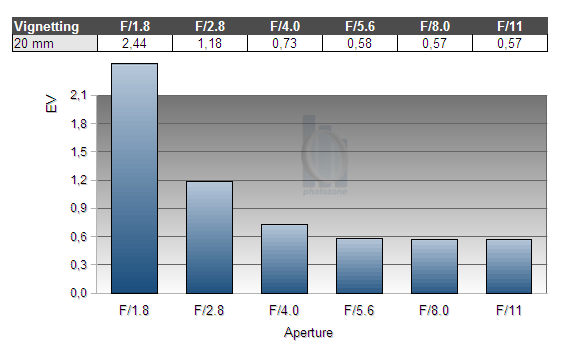|
Page 2 of 3

Distortion
There is a moderate amount of barrel distortion of around 1.6%, which is an average value for a prime of this focal length. So, nothing to be excited about, but for typical applications (especially landscapes) not an issue in the field really.

The chart above has a real-world size of about 120x80cm.
Vignetting
This took us a bit by surprise, the lens shows a huge amount of vignetting wide open that you'd usually only expect from a Zeiss lens. However, the AF-S 20/1.8 shares a fairly small front element with its siblings (much smaller than a filter thread diameter of 77mm suggests), so this probably explains it a little.
As usual, vignetting can be "cured" by stopping down. At f/2.8, the light fall-off towards the borders is already down to roughly 1.2 stops, even though this is still an amount that can be disturbing with some subjects.
At smaller apertures, vignetting is well below 1 EV and not an issue anymore.
We're performing our vignetting analysis based on
(uncorrected) JPEGs straight from the camera. The JPG engine of the Nikon D3x features a rather flat
gradation curve, thus has a moderate contrast characteristic, resulting in comparatively low vignetting figures - the
corresponding Canon figures are roughly 40% higher due to the more
aggressive default contrast setting.

MTF (resolution)
The center resolution of the AF-S 20 is impressive, reaching excellent figures wide open already, improving even more by stopping down and staying on this high level until diffraction takes its toll from f/11 onwards.
The borders and corners follow quite a bit behind, with "just" good values at f/1.8 and f/2.8, improving to very good figures by further stopping down. The best resolution across the whole frame is reached at f/8.
It is worth mentioning that the lens showed only a very small amount of focus shifting when stopping down (residual spherical aberration).
Please note that the MTF results are not directly comparable across the different systems!
Below is a simplified summary of the formal findings. The chart shows line widths
per picture height (LW/PH) which can be taken as a measure for sharpness.
If you want to know more about the MTF50 figures you may check out the corresponding
Imatest Explanations

Chromatic Aberrations (CAs)
Chromatic aberrations (color shadows at harsh contrast transitions) are moderate for such a wide lens, with just above 1 pixel on average at the image borders throughout the tested aperture range.

Bokeh
It is usually not the primary feature of a wide-angle lens do deliver images where the main subject is separated form the background. However, the Nikkor combines a fast aperture with a rather short minimum focus distance, and this does indeed offer the opportunity for a nicely blurred background with close-up subjects.
Usually, wide-angles don't perform that well in this discipline, but the AF-S 20 produces and nice and rather smooth background AND foreground blur, also in the transition zone between in-focus and out-of-focus areas, where many lenses struggle.
Background highlights show a small amount of onion-ring like structure, but otherwise are mostly evenly filled and show a fairly small amount of outlining. Unavoidable, though, is some noticeable bokeh fringing (see next section), as well as some cut-off of highlights towards the image borders, which is an effect of the rather small front lens diameter.

Bokeh Fringing
Bokeh fringing is a common issue with relatively fast glass. It's visible as halos of different colors in out-of-focus areas - magenta (red + blue) in front of the focus point
and green beyond.
Typical for most fast primes, the AF-S 20mm shows noticeable bokeh fringing at large aperture settings, which can of course be reduced by stopping down.
In addition, these shots also illustrate that there is no visible focus shifting when stopping down.
|